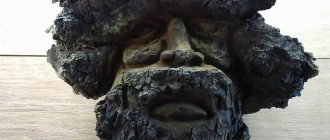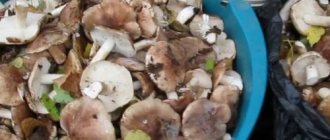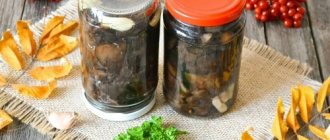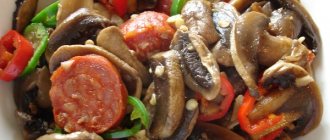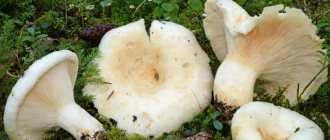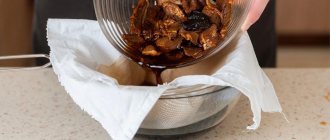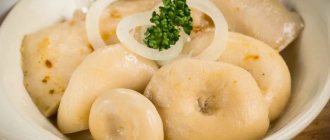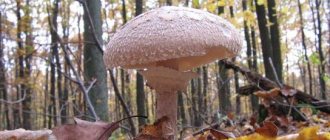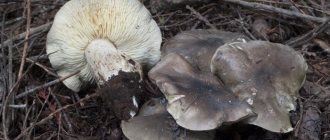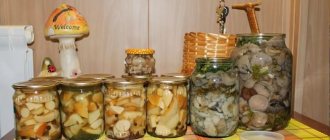Why does a mushroom become wormy?
First, let's find out where worms come from and on what basis they choose their victims.
Do they eat all mushrooms? Why do they spoil our fun? Worms are very unpleasant creatures. It is believed that they are especially voracious in rainy summers. In fact, this observation is not entirely correct. Wormy mushrooms can be in any weather. The degree of activity of these animals does not depend on air humidity and temperature. Mushroom worms are the larvae of various flies and mosquitoes; under the cap they find shelter and food for themselves. But unlike people, the forest beauty itself does not suffer at all from the presence of worms in its pulp. On the contrary, these larvae perform a very significant role - they facilitate the transport of spores into the soil, which subsequently increases the amount of grown crop.
Some types of mushrooms, to the delight of people, cope well with reproduction on their own and do not allow any parasites to get close to them. Sometimes you can hear the opinion that worms love all edible species, that they do not touch only those that people should not eat - poisonous mushrooms. But this statement is not true. There are species in nature that are never wormy, but they are very tasty and not at all poisonous.
Processing such specimens only involves removing stuck leaves and blades of grass, washing and cooking - boiling or frying. These include cute little foxes. They are very tasty; some experts in quiet hunting and gourmets prefer to eat them only. Being very cute, they delight the eye both in the forest in a clearing and on a plate at the table. Chanterelle is a very popular mushroom.
Taste qualities
Honey mushrooms are valued for their exceptional scent and ability to collect large quantities in a short time.
Young mushrooms have strong and elastic white flesh. An edible adult honey fungus loses its ability to retain juices in the fruiting body. Therefore, its leg often dries out, the flesh becomes whitish-gray or yellowish, loose.
Young and adults have the same taste
Both young and adult mushrooms differ little in taste. In some European countries, gourmets even prefer overgrown ones - the hardness and fibrousness of the pulp appeals more to their tastes. When cooking, do not use rotten, wormy or false specimens, because... they will give the dish an unpleasant smell and a bitter aftertaste.
Is it possible to save a wormy mushroom?
What to do if the mushroom is wormy, but it’s a pity to throw it away? Especially when he looks so strong and young. How joyful it is to meet a boletus, saffron milk cap, and boletus in a clearing! But often joy gives way to disappointment. It is very disappointing to see holes in the cut, indicating the presence of unpleasant guests. Of course, you don’t want to see worms in mushrooms. Is it possible to save your loot? Should you put your find in a basket and bring it home? Or is it better to throw it away immediately? It often happens that there are a lot of slightly damaged finds. Is it possible to eat them?
In general, you can eat them; the presence of worms in mushrooms does not make them poisonous. This has been tested over many years of experiments and confirmed by scientific research. You cannot get poisoned by wormy mushrooms; they are quite edible, but not everyone will like it if a worm gets into their plate. This creates a difficult situation - it’s a pity to throw it away, and it’s impossible to offer it to guests. Over the course of several decades, especially compassionate lovers of forest gifts have experimentally discovered how to get rid of the presence of someone in the mushroom pulp without much effort. And after appropriate processing, they ate them with gusto. So, if the mushroom is not rotten, it makes sense to fight for it.
Processing mushrooms in this case involves the following steps. You need to cut them into large pieces, then soak them in cold, highly salted water and leave for 3-4 hours. It is assumed that the worms will begin to flee, the cause of which is the salt. This is, of course, an unpleasant sight, but the desired result will be achieved. In this way you can easily clean the mushroom from unpleasant creatures. All that remains is to rinse everything thoroughly after the time has elapsed. When the worms from the mushrooms are removed, the forest beauties are saved, you can send them to the kitchen and start preparing your favorite dishes that will decorate your table.
Another popular method is drying mushrooms. It is also very easy to clean them of worms this way. The sun will help you cope with them. They will leave their habitat on their own in a hurry during the drying process. Processing mushrooms from unpleasant creatures in this way is not difficult.
Cooking honey mushrooms
Collected overgrown honey mushrooms are cleaned before any processing. The stems are removed, the caps are checked for worms, and if there are any, the fruiting bodies are discarded. Use a knife or the hard part of a washcloth to remove the spore-bearing plates.
The remaining high-quality fruiting bodies are soaked in cold water for 40-50 minutes. To better clean mushroom caps from parasites, add 2-3 tbsp. l. regular salt. It is recommended to change the water three times to achieve maximum results.
If the mushrooms are sent for drying, then their contact with water is minimized. The spore plates are removed with a damp washcloth, which simultaneously removes dirt from the cap. The fruiting bodies are left in a sunny, ventilated place until fully prepared. Then they are ground into powder or cut into pieces, added to soups and side dishes, salads, pates and other dishes.
By the way. If the legs of overgrown honey mushrooms have a “decent” appearance, after being separated from the caps, they can be used to prepare caviar or pate.
Heat treatment is carried out before cooking adult mushrooms. It is divided into 2 approaches lasting 15-20 minutes. Each time the water in which honey mushrooms are boiled is changed to clean. After this, overgrown honey mushrooms are added to various dishes:
- after half an hour of cooking, the caps are marinated with the addition of spices and served as a finished dish, appetizer, or side dish;
- fried in sour cream, with vegetables, potatoes, onions, served as a main dish;
- added to soups and sauces, used as a filling for pies.
So that everyone is happy
You can save wormy mushrooms. But to do this or not, everyone decides for themselves. Not everyone can calmly eat forest delicacies, bearing in mind that quite recently worms lived in them. For such capricious mushroom pickers, there is only one way out - to put only whole mushrooms in the basket without a hint that someone has had time to taste them.
Already cut worm finds can be hung on a twig. They will dry out and become a treat for some bird or animal. Some nature lovers do just that. In this way they do a good deed for the forest inhabitants. And for yourself and your loved ones, if you wish, you can always pick up clean, unbitten, worm-free mushrooms. There may not be so many of them, but it will be more pleasant to eat. You can pamper your guests with your favorite delicacies.
But we must not forget one important rule - you need to be very careful with mushrooms, this is food that is difficult for the stomach; small children and people with poor health are not recommended to eat mushroom dishes. And you can collect forest gifts only in environmentally friendly places, away from roads. Then, even if they are a little wormy, they will not cause harm to health. Follow these simple requirements so that quiet hunting brings only joy and pleasure to you and your loved ones.
dachadecor.ru
We are not the only ones who like porcini mushrooms. Nothing strange - the most delicious mushroom was tasted by animals, slugs, insects and their larvae. There are more than 300 species of insect pests dangerous to porcini mushrooms. It may be that while you are processing the harvested crop, some cockchafer may chew the entire stem from the inside.
But what to do if you come across a not very wormy porcini mushroom? It’s a shame to throw it away, it’s scary to leave it, what if you get poisoned?
Where do worms come from in mushrooms?
The worms that we see in mushrooms are insect larvae hatched from eggs laid by all kinds of fungus mosquitoes and flies. Sometimes thick, hard worms - wireworms or larvae of click beetles - are also found in mushrooms. Any insects that lay their eggs in mushrooms prefer to fly in dry, sunny weather, so at such times the likelihood of encountering a wormy mushroom is higher.
Is it possible to get poisoned by a mushroom with a worm?
Yes, but not from worms, but when the mushroom itself is poisonous. The opinion that there are no worms in poisonous mushrooms is wrong, it’s just a myth. For example, pigs, which cannot be eaten without boiling, easily get worms. At the same time, there are never very tasty hedgehogs or completely safe chanterelles. But the worms themselves do not make the mushroom poisonous. And arguments based on the fact that “waste products” are poisonous have no basis.
What to do if you come across a not very wormy porcini mushroom?
If, after cutting the mushroom, it turns out that there are worms in it, you can choose one of several options:
1. Don't take it. In this case, it is better not to leave it on the ground, but to put or pin the cap on a branch. Then it will not rot, but dry out. After this, the spores will mature and be dispersed over a large area. Next year you will be able to harvest a good harvest from new myceliums in these places.
2. You can cut the white mushroom along its entire length into two halves and see if it is completely worm-eaten. Only the leg can be wormy. Then just cut off the cap and take it with you.
3. Wormy spots, if there are not many of them, can simply be cut off.
4. Or you can take the whole mushroom, if it is not old and flabby. At home, such mushrooms are cut and placed in a salt solution for several hours (2 tablespoons per medium saucepan). After this, all the larvae present in the mushrooms will come out. After the salt water has been drained, the mushrooms must be thoroughly washed.
5. You can use a slightly wormy mushroom for drying in a hot oven. As soon as the mushroom begins to dry, the worms will fall out of it. It's best to dry them in something like a sieve with large holes, so you don't have to separate them from the dried mushrooms later.
But in general, porcini mushrooms become wormy very quickly, since insects love them very much. Therefore, it is best to choose the time of their mass release for collection. This usually happens at the end of summer - beginning of autumn, after a slight cold snap and rains. This period is very short, one or two weeks, so you should hurry to visit the places that you know as mushrooms.
sibgrib.ru
How to remove by soaking
It is worth getting rid of worms in mushrooms immediately after they have been collected. To do this, they need to be cut into large pieces. First, the leg of the body is cut off, the tubular layer at the cap is removed, and the leg is divided in half. The parts are placed in cool, salted water for several hours. For 5 liters of water you need to take 1 glass of salt. Having smelled the salt, the worms will come out. This way, all the larvae will leave the fruit. All that remains to be done is to rinse them well and remove traces of the presence of pests. After this, you can start cooking.
It should be taken into account that different types of mushrooms have different densities. The peculiarity of preparing porcini mushrooms for consumption is that they should be kept in water longer than others - 3-4 hours. Milk mushrooms must lie in water for at least 24 hours. Russulas and pigs can be kept for a couple of hours.
Important! If the fruits are too spoiled, rotten or rotten, there is no point in saving them - there is nothing useful left in them.
If the worms have eaten only a small part of the body, you can simply cut off the damaged part with a knife. The main thing is that the fetus does not show signs of decomposition. Cleaned mushrooms can be fried, pickled, boiled, or pickled.
Is there a danger of poisoning from mushrooms with worms?
The danger of poisoning from mushroom worms is quite high. Contrary to popular belief, worms can also grow in poisonous mushrooms. There are no wormy hedgehogs or chanterelles.
However, pigs, which cannot be eaten without prior boiling, are highly susceptible to infection. The mere presence of worms does not make mushrooms poisonous.
If you plan to take mushrooms for yourself, you do not need to take specimens with worms. The rule of careful selection should be followed. It should be noted that healthy mushrooms that are kept for some time together with spoiled ones can also be attacked by parasites. The fact is that worm larvae are very gluttonous, so the speed of their transition to healthy specimens is extremely high.
If you nevertheless decide to collect mushrooms with worms, you need to cut off all areas affected by larvae as quickly as possible. This will make it possible to protect healthy mushrooms. Upon arrival home, the mushrooms need to be processed immediately. To do this, you need to cut each affected mushroom into pieces and put it in heavily salted water for 3-5 hours. This way all the larvae will disappear.
There is another way to fight worms. You need to take any wire rack and put mushrooms on it. As they dry out, the worms will fall off and fall down.
Fox's "doubles"
Chanterelles are yellow, yellow-orange. The hat is darker, the leg is lighter. When assembling, they are easy to break. The cap is wavy and smooth only on young foxes. On the lower part of the mushroom there are not plates, but wrinkles (chanterelles are close to tinder fungi). Wrinkles go down the leg, imperceptibly moving into it. A very tasty mushroom.
False chanterelles (talkers) grow next to the chanterelles. They are edible, just tasteless. The mushroom is lamellar. The records end very abruptly. The talker is not poisonous. There is no danger of poisoning.
You can confuse the chanterelle with the yellow hedgehog. There's nothing even to be afraid of. The hedgehog is not only not poisonous, it is considered a delicacy. Its sign is that on the underside of the cap there are not plates, but crumbling needles.
What to do with wormy mushrooms
There are three options for how to deal with wormy mushrooms:
- Leave mushrooms in the forest. Often mushrooms affected by parasites are already rotten. The caps of such mushrooms can be left on the plot so that the mycelium starts,
- Take the mushrooms and subject them to thorough pre-processing. Even after this, it is recommended to fry or boil the mushroom.
Wormy mushrooms (non-poisonous) do not pose any obvious harm to health. However, there are various worms that, when settling in the human body, provoke various negative conditions.
The process of movement of larvae and the vital activity of adults in the human intestine leads to dangerous diseases.
Rules for collecting mushrooms
Basic rules that will help make mushroom picking as easy and successful as possible:
- Mushrooms are collected in forests or on their edges. Find out from other mushroom pickers from your favorite gathering places. Or use a mushroom map of the area.
- The mushroom picker’s equipment should be light and comfortable, the knife should be sharp and, as they say, “fit the hand,” and a wicker basket in which there is constant air movement is suitable for transporting mushrooms.
- The best time to collect is early morning, when the sun's rays have not yet dried the dew on the caps of the fruiting bodies.
- It is better to collect those mushrooms that you are completely sure are edible. It is better to throw away those that cause even the slightest doubt, so as not to spoil the entire harvest.
- To preserve the mycelium, it is better to cut the mushrooms at the base or carefully twist them out of the ground. After this, it is advisable to sprinkle the cut (twisting) area with earth.
- Preference should be given to young mushrooms without damage. Do not rush to throw away slightly wormy mushrooms. They can be folded separately or, after removing damage, they can also be sent to the basket.
- The cut mushroom is carefully inspected and soil and debris are removed. It is preferable to put them in a basket with the caps down to save space and prevent breakage and damage. In addition, larger and heavier specimens are usually placed at the bottom of the basket, and small and light ones at the top.
- It is better to process the harvested crop immediately after returning. If stored for a long time, they deteriorate and lose their taste.
Diagnostics
In the human intestine, a large worm is clearly visible on an ultrasound screen. If the parasites are very small in size, it will not be easy to identify them in the body.
In this case, a method such as a blood test for waste products of worms and the presence of pest eggs comes to the rescue.
If there is any suspicion of helminthiasis, you need to examine the stool, because most parasites live in the human intestines.
It should be noted that to make a diagnosis, doctors use the following methods:
- Stool analysis for protozoa,
- Ultrasound,
- Blood analysis,
- Tissue biopsy,
- Sputum analysis,
- Intestinal endoscopy,
- X-ray.
Treatment
If the doctor determines that the patient has parasites, therapy with specific agents should be started immediately. Preference is given to complex treatment to combine the positive properties of several drugs.
So, first they use medications that weaken worms, these can be drugs based on Levamisole (Dekaris). A few days later, the person is prescribed another anthelmintic, this can be Nemozol or Vermox.
Parasites in the body are paralyzed after the use of special agents. This effect eventually leads to the death of the worms. The doctor prescribes drugs at his own discretion, based on the existing clinical picture. The list of medications that are most often used to treat helminthiasis is as follows:
- Biltricide with the active substance praziquantel. The drug causes muscle stiffness and the parasites are paralyzed,
- Vormil and Nemozol stimulate irreversible biochemical processes in helminths,
- Decaris or Levamisole - the drug disrupts the energy exchange processes of parasites,
- Helmintox and Nemocid have a paralyzing effect,
- Vermox or Mebendazole eliminates cellular synthesis and energy metabolism of worms.
Additional treatment is also used:
- Sorbents: Enterosgel, activated carbon. Medicines remove toxic waste products of worms that are in the body,
- Symptomatic remedies: painkillers and antiallergics. Necessary to eliminate associated symptoms,
- The use of probiotics is indicated to restore intestinal microflora.
These drugs are well tolerated by people of any age. They are also recommended for preventive purposes. Lactation and pregnancy are special indications for therapy exclusively under medical supervision.
Attention should be paid to eliminating the possibility of re-infection. In the human body, worms and eggs that are present will constantly come out, so underwear and bed linen must be constantly changed.
Currently, medicine offers some belekarsten methods of treatment, for example, therapy based on bioresonance vibrations of organisms.
Preventive measures
As you know, parasites can settle in the body of absolutely any person. If you don’t give them a chance to get inside the gastrointestinal tract, you can avoid complications without much effort.
To do this, sometimes it is enough just to systematically observe the rules of personal hygiene.
Doctors also provide the following list of recommendations:
- Wash your hands before eating and after coming from outside with soap,
- Do not drink water from unknown sources,
- Fish and meat should always be cooked
- Wash mushrooms and other plant products thoroughly and clean them of parasites,
- Do not eat lightly salted or raw fish (especially river catch),
- Swimming in open waters should only be done if there is no doubt about it.
- Do not kiss pets, have them checked regularly by a veterinarian,
- When visiting exotic countries, pay attention to protecting exposed areas of the body from blood-sucking insects.
Description of edible overgrown mushrooms
Overgrown ones do not always attract attention with their appearance and taste.
Honey mushroom has a significant advantage - it retains its beneficial properties for a long time. But the appearance of overgrown specimens differs significantly from young fruiting bodies:
- The shape of the cap changes. In autumn mushrooms, the upper part opens into a hemisphere, in summer mushrooms it becomes horizontal and even. The size of the caps also increases to 10-17 cm in diameter. The color darkens to brown or brown. The small scales covering the top almost completely disappear, smoothness appears, and the moist oiliness disappears.
- The honey fungus has spore plates, which turn from flesh-colored and white to pink or brown in an adult specimen. Spores often leave their container, landing on the caps of neighboring mushrooms. A similar phenomenon resembles mold developing on the surface of the caps located below. To check this, simply run your finger over the cap with “mold” and spores will remain on your fingertip. In older representatives, the spore plates begin to rot and become covered with black spots.
- Overgrown honey mushrooms rest on thick, tall legs. Sometimes the lower part begins to become decrepit, and dry places appear. The girdle, typical of the young Openka, almost completely disappears. False species do not have such a mark, so it is easy to confuse edible old mushrooms and inedible ones and you need to be extremely careful.
- Young specimens are known for their strong, pleasant smell, which persists even when cooking. Overgrown fruiting bodies, if they do not rot, have the same smell, but it is weaker. False honey mushrooms are endowed with an earthy, unpleasant trail, which distinguishes them from their edible relatives.
Where and why do worms appear in mushrooms?
Worms appear in mushrooms from the larvae that some varieties of flies and fungus gnats lay. In addition, another insect that lays its larvae on mushrooms is the click beetle , the offspring of which are wireworms, which differ from other individuals that eat forest delicacies in thickness and rigidity.
Like most living things, insects love dry and sunny weather, so it is at this time that wormy mushrooms are much more common.
In addition, by eating mushrooms, worms become carriers of spores, which further contributes to the spread of mycelium.
If you come across a worm-bearing mushroom in the forest, then you need to cut off all the damaged elements from it, since the worms eat mushrooms very quickly and can instantly spread from damaged specimens to clean ones.
What to do with wormy mushrooms
If the mushroom is all rotten and wormy, then it is better to leave it in its place and not touch it, but go look for decent, clean specimens.
If the mushroom is only slightly affected by worms, then you can take it, but at home you will need to carry out simple manipulations with it:
- Cut into small pieces and pour heavily salted water for 2 – 4 hours.
- Send the mushroom to dry on the stove, in the oven or in the sun, but preferably on a grated surface - when it starts to dry out a little, the worms will immediately jump out of it and will not be able to get back.
Is it possible to eat wormy mushrooms?
As noted above, if the mushroom is slightly damaged and it is subjected to simple processing, then no harm will be done to the body, but on the contrary, our body will receive maximum benefit due to the presence of a sufficient amount of vitamins and microelements in the mushrooms.
If the mushroom is simply teeming with worms and will not be subjected to additional processing, then the possibility of infecting the body with helminthiasis .
This disease can be detected in a person by conducting a series of diagnostic studies: conducting an ultrasound of the intestines and x-rays, donating blood, sputum and feces for analysis, conducting an endoscopy of the intestines and performing a biopsy of its tissues.
If such a serious disease as helminthiasis is detected, it is necessary to immediately begin treatment. But it is important to remember that treatment should only be prescribed by a specialist.
Treatment
First of all, a drug is prescribed whose action is aimed at weakening the action and reproduction of worms; these are drugs whose main active ingredient is levamisole. Another drug that is prescribed at the first stage of treatment of the disease are drugs that have an anthelmintic effect ( Biltricid , Vermox , Wormil , Helmintox , Mebendazole , Nemozol , Nemotsid ).
The use of these drugs leads to the fact that the movements of the worms are paralyzed, and accordingly, after some time without movement and without food, they will begin to die.
Next, you need to take a number of other medications:
- Sorbents that help remove waste products of worms and their dead specimens from the human body (“Enterosgel”);
- Probiotics, whose task is to restore the disturbed intestinal microflora (Linex);
- Antiallergic, the use of which is required only by a small number of people with helminthiasis, in case the body exhibits allergic reactions to the presence of parasites in the body, or to taking certain medications.
It should be taken into account that dead worms, their waste products and larvae will leave the human body not only through bowel movements, but also spontaneously. Therefore, during the treatment period, it is necessary to carefully monitor your hygiene and change not only your underwear, but also your bed linen more often.
In addition, one of the folk remedies for ridding the body of parasites is the use of tansy , 1 teaspoon of which (should be crushed and in the form of a powder) should be consumed twice a day on an empty stomach (about 20 - 30 minutes before meals). The mixture should be washed down with a small amount of boiled water at room temperature. The course of treatment is a month.
In addition to this method of treatment, you can use enemas , which will contain a decoction of herbs. To do this, you need to pour 1 tablespoon of the grass, crushed to a powder, with 0.5 liters of hot, but not boiling water, leave for half an hour and use before bed.
Poor heat treatment of mushrooms can lead to the appearance of a disease such as helminthiasis in the human body.
If you still want to protect yourself and your family from the possible consequences of eating wormy mushrooms, and also save yourself from unnecessary hassle, then it is better to leave the wormy specimen in the forest, preferably placing it on some bush, thus preparing food for forest birds during their possible starvation due to lack of other food.
parazits.ru
Eating
A wormy mushroom does not cause poisoning, unlike a poisonous or inedible fruiting body. Old, overgrown specimens are usually affected by these pests. But these lose most of their taste; the flesh is hard or too friable with an unpleasant aroma. If you eat such a specimen, it will lead to significant digestive upset and intoxication of the body.
Irina Selyutina (Biologist):
Many gastroenterologists are sure that it is not worth eating wormy mushrooms, because. worms produce toxins that are practically impossible to remove from the fungus either by heat treatment or saline solution. In their opinion, only lamellar mushrooms can be saved, which have a dense structure of the fruiting body and it is not difficult to cut out the affected areas. But it is better to leave worm-bearing tubular mushrooms in the forest - even by cutting out the affected parts it will not be possible to completely remove the worms.
If a spoiled boletus, boletus, or butter dish ends up in the hands of a mushroom picker, it’s worth putting in a little effort and preparing it for use. To do this, the fruiting body is cut into large pieces and filled with a solution of salt water. After 2-3 hours, when the pests emerge, the mushrooms are removed from the solution. Attention! The mushrooms are removed rather than drained. They do this in order not to leave pests at the bottom of the dishes. Then they are thoroughly washed, dried and prepared for consumption in the chosen way. You can use a more concentrated solution - 2 tbsp for 3 liters of water. l. table salt and leave the mushrooms for 30-40 minutes.
Another way to use mushrooms damaged by worms is to dry them. During this process, the parasites will almost immediately leave the wilted fruiting bodies on their own, having lost the nutrient medium for their existence. Later, before cooking, the mushrooms are thoroughly washed.
Irina Selyutina (Biologist):
What can we say about the two, perhaps, most common mushrooms:
- Honey fungus: this mushroom can be called perhaps the most “understandable” in terms of worminess: it always “tells” the truth. If you see holes in the cut, simply cut off the stem as close to the cap as possible. Usually in these mushrooms the worms finish building “catacombs” on the approaches to the cap. And it is used for food.
- Butterfly: almost always wormy, especially if you are late with the collection time (within 24 hours after regrowth).
The larvae (worms) have an excellent appetite. If you brought home a wormy mushroom and for some reason postponed the “joy” of processing a little until later, then by the time of processing it can already serve as a sieve in the kitchen. Therefore, it is best to cut out the wormy parts immediately at the collection site and put them in a basket already “clean”.
By removing the wormy parts of the mushroom right in the forest, you save your work, because after eating your cozy “house”, the worms will quickly move to a nearby vacant “home”. In this case, the mushroom picker will bring home more wormy mushrooms than he collected.
Is it possible to eat wormy mushrooms?
Most are more inclined to believe that there is nothing dangerous in this. The worm is not a fool; it will not eat a bad mushroom. To some extent this is true. After all, there are quite a few intact mushrooms in the forest, therefore, even with industrial harvesting, specimens that are less than half damaged by worms are considered quite suitable for consumption. Of course, before sending them to store shelves, they subject the mushrooms to special processing. Therefore, if you decide to collect mushrooms for yourself, then you should not take wormy ones. Follow the rule - less is more. Otherwise, you may have a problem with how to protect uninfected mushrooms from worms. After all, the larvae are so voracious that they can quickly destroy all your “prey” collected in the forest.
What to do with wormy mushrooms?
If you still decide to collect them, then cut off all the areas damaged by the larvae. This way you will have at least some guarantee that other good mushrooms will not be harmed. When you get home, if possible, process them immediately. To do this, cut each wormy mushroom into pieces and place it in highly salted water for several hours. This way all the larvae will come out.
If you decide not to take a wormy mushroom, then under no circumstances throw it on the ground. It’s better to put it on a branch or pin it on a stick with the spores facing down. In this position, the mushroom cap will not rot, but will dry out - the spores will begin to gather dust, and soon new foci of mycelium will appear nearby. There is another plus to this. Dried mushrooms will serve as excellent food for animals in the cold winter. The forest inhabitants will only thank you.
Preparing mushrooms
It is better to sort mushrooms into healthy ones and wormy ones right in the forest. The wormy parts should be cut off immediately and thrown away. If they remain in the basket, the worms will move to an adjacent uninfected fruit. The wormy body can be pricked on a twig - the spores will spread in the air, and next year there will be a generous harvest in that place.
The first thing to do is to make sure that worms are actually present in the fruit. You can check this by cutting them along their entire length into two parts.
Butterfish are the most susceptible to worms. Already on the second day of regrowth, the larvae begin to eat their legs. If there is any doubt whether the honey fungus is wormy, you need to trim its stem shorter. As a rule, the passages end under the cap - such a mushroom can be eaten. There are practically no parasites in forest champignons.
Worms are almost invisible in fried or stewed fruits. But if you cook the broth, an unpleasant situation is possible, so it is advisable to strain it before serving.
The white mushroom is wormy. What to do?
The porcini mushroom is considered the most desirable prey not only for humans, but also for worms. It usually grows in groups. Therefore, when you find one mushroom, be sure to look around; most likely, you will find several more. Harvesting an undamaged crop is a great success! But most often, such mushrooms have already been tasted by worms or other forest inhabitants. But don’t be upset, this doesn’t mean that they aren’t worth collecting. You just need to remember a few rules. Worms damage the porcini mushroom, usually from the tubular layer. Therefore, before putting it in the basket, lightly cut the center of the cap. If there are no worms there, then you can safely take it. If you still find passages and larvae in the cut, then to be sure, check the stem of the mushroom. Perhaps it will still be untouched.
So let's conclude: is it possible to eat wormy mushrooms? As has already become clear, there is no clear answer to this question. If the mushrooms are not severely damaged by worms, then they can be eaten. Just be sure to soak them in salt water before processing. But if the mushroom is not only wormy, but also old, it is advisable to leave such a specimen in the forest. Otherwise, they can get poisoned. Therefore, it is up to you to decide whether you can eat wormy mushrooms or whether it would be better to refuse them.
fb.ru
Many of you love mushrooms very much and willingly collect them or buy them at the market. Amazing! Mushrooms are very tasty and healthy.
However, almost every mushroom picker or mushroom lover is faced with an unpleasant problem - wormy mushrooms.
Most often, we throw away all the mushrooms on which we see even a small hole. Remember: you cannot be poisoned by worms in mushrooms (unless these mushrooms are poisonous). Therefore, the problem of wormy mushrooms is more aesthetic.
The largest restaurants in the country buy mushrooms from private owners by the hundredweight, prepare a variety of dishes from them, and no one complains. Want to know where the worms go? Are all mushrooms really examined under a microscope?
Of course not. It’s just that restaurant chefs know very well how to get rid of worms.
Let's reveal their secrets:
- Buy only fresh mushrooms. They cannot be stored for more than 3 hours. The more they are stored, the more wormy the mushrooms become.
- Mushrooms picked in the rain will spoil especially quickly, so try to heat-treat your mushrooms as quickly as possible.
- If for some reason you cannot immediately deal with mushrooms, place them in water.
There are two ways to get rid of worms :
- Coarsely chop the mushrooms and place in a saucepan with salted solution. The solution is prepared as follows: 1 glass of salt per 5 liters of water. Porcini mushrooms are kept in solution for 3-4 hours. Russulas and pigs are less dense, so they should lie in the water less. Milk mushrooms are generally soaked for at least a day. Then the water is drained and the mushrooms are thoroughly washed in a colander. The worms will fall out into the brine solution.
- You need to dry the mushrooms. Worms fall out when dried. There are two ways. First you need to cut the mushrooms into thin slices, then string them on a thread and hang them. Just be sure to put something on the floor. After 24 hours, all mushrooms will be free of worms. Or (if there are a lot of mushrooms), mushrooms cut into thin slices are dried in the oven at the lowest temperature. Then the mushrooms are shaken off the dried worms that have crawled out.
In the oven, it is better to use something like a sieve with large cells, and place an ordinary baking sheet down. These simple devices allow you to immediately obtain clean mushrooms. All the worms will fall through the holes in the sieve onto the baking sheet.
That's all the simple secrets. If the information was useful to you, do not forget to share it on social networks
lastici.ru
Since childhood, I have also thought about where worms come from in mushrooms. As an adult, I read in some book that these are the larvae of a mushroom fly. But no matter how much I looked for at least some information about her, I found nothing. I looked closely at the forest flies - blue, black, gray and yellow - and could not guess which one was destroying the mushrooms.
And how can a fly bite through a strong mushroom? And sometimes he hasn’t even been born yet and... he’s wormy. How can a fly get to it?
And one more mystery haunted me. You will find an old, but still strong boletus or boletus, break the hat, and in it along the bottom of the mushroom pulp there are wide dark passages, like tunnels. And a tiny insect, like a small mosquito, will quickly get out of there. Before you have time to see what it is, phew, she’s gone, she’s disappeared somewhere. What was amazing was not that the insect disappeared so deftly, but how it could make such moves, a huge amount of work for it. Since childhood, we have known other mushroom eaters. They placed the slug-snail on the palm and chanted: Snail, snail, let out your horns - I’ll give you a piece of the pie. She really stretched out and, amusing us, released “horns” - black, with a knob at the end. Then it crawled, leaving behind sticky mucus. We respected the snail not only for its wonderful “horns” that can be released and hidden. Mushrooms with a snail were more often happy - without worms, just like with a wireworm - an elastic red worm that loves mushroom stems, especially white ones. It’s also not much of a hassle: you pinch it by the tip with a knife and pull it out of the stem. But nasty little worms usually don’t exist where there are wireworms. But the “work” of snails and wireworms was not surprising: they ate very little in comparison with their considerable size. And the mysterious tunneler, who, by the way, also gnawed her holes in clean, worm-free mushrooms and in this sense also deserved respect - she was insignificant. Insignificance - that’s all her title is. We caught her and looked at her. The insect most resembled a skinny winged ant: a narrow abdomen, lacquered like an ant, and a thin waist. And long antennae, and jaws that easily bite through the fibers of a loose, cotton-like mushroom... One is not an ant: the abdomen ends in a long thin “tail”. What kind of miracle is this? I again looked through a bunch of books, and again I did not find the answer. But one day I got lucky. I met a beautiful, tanned porcini mushroom with a white border along the edge of the cap, admired it - and suddenly I saw that same tunnel-dwelling insect. She crawled out from somewhere, ran around the hat and stood on her head, raising her belly up. “Well,” I think, “miracles upon miracles: my stranger is also a gymnast, it turns out...” Then I realized that this was not gymnastics, that the unusual stance was just a way to pull up the “tail” and stick it into the mushroom cap. I realized that the “tail,” in fact, was not a tail or some other decoration, but a needle for piercing the tough skin of the cap. The insect pierced it once, and twice, and three times, leaving clearly visible points. And she didn’t just pierce it, but stuck some other, even more subtle and cunning instrument into the cap, visible only through a good magnifying glass. The rest was simple. I covered the mushroom with brushwood, and two days later I came and cut the cap at the puncture points. Not only me - everyone would have a guess in this case that the tunnel walker and the progenitor of mushroom worms, as they say, are the same “face”, that the insect is that very “fly”, no matter how it disguises itself as a fly an ant and no matter how clean the mushrooms in which it makes its moves are. And so it happened. Both secrets were revealed at once, when in the cut cap, at a centimeter depth, there were entire nests of yellow, waxy, egg sticks, from which mushroom worms emerge. Now it was possible to understand why the mushroom turns out to be wormy even before it is born, completely hidden by fallen leaves: the “fly” pierces it with its sting and inserts the ovipositor directly through the leaves. It was also possible to recognize the breed of the “fly” itself: its relatives are equestrians, so nicknamed because they lay eggs in the larvae of other insects and in the early period of development they seem to ride on someone else’s hump. The parasites “run over” someone else’s larva to death, and since these larvae often belong to pests of gardens and fields, parasitic parasites are specially bred and even bought in countries near and far. Is the fly a mushroom? There is probably no person who would not wish her to die, damned thing. And she lives and multiplies. Before you know it, a brood of worms appears from every nest of yellow sticks. Of these - new “flies”, and again all over again... Just as bees fly around flowers in a meadow, so “flies” fly around mushrooms on warm, fine days. And even in the rain they don’t yawn, they climb under the caps and poke needles into the tubes and into the tender neck of the mushroom. They search for their prey, more accurately than the most skilled mushroom pickers, by smell. Therefore, a mushroom covered with leaves does not escape their sting. The less the mushrooms smell, the less often they encounter the destroyer “fly”. You sometimes see the real triumph of these seemingly harmless insects on the souring fly agaric: they swoop in in a flock, fuss and prick, as if even intoxicated. And they sometimes fail. Due to some vagaries of the weather, they will miss the deadline, grab it - the mushroom has become rough, bends, the needle does not fit. And there stands a hefty white one, as vigorous as a turnip, when even the smallest thing around has long been worm-eaten. After all, “flies” reign all summer. Only the autumn frost will stop their raids. And maybe that’s why it’s especially pleasant to go mushroom hunting in late autumn, when there is no omnipresent mushroom pest. Yakovlev K.F. 'Forest diva' Source: dendrology.ru
handf.mirtesen.ru
Severina replied on August 29, 2007: It’s just unpleasant to eat worms. There is no threat. Meat is meat everywhere))) especially after cooking))
Intja replied on August 29, 2007: Personally, I don’t take wormy mushrooms just out of a feeling of disgust. Why collect them if there are enough good, non-worm-free ones. True, there are exotic lovers who collect them, use a special technology to soak them in salt water, boil, steam, fry - it’s so much hassle that you won’t even want mushrooms after that - I wouldn’t eat such mushrooms, it’s disgusting! It is difficult to say about their health hazard, but they are probably dangerous - it is not enough for hunters to experiment. To be honest, I don’t know about the reasons for the appearance of worms in mushrooms.
Otto Maier replied on August 29, 2007: These are not worms, these are larvae of flies, of various types, or other insects that managed to lay their larvae on the fresh fungus. But they often don’t take it because after these swallows there is nothing left to eat; the larvae have already eaten the most delicious food) As a rule, the larvae are edible and not dangerous if processed like regular food. Moreover, they are high in calories, like meat. Many peoples and tribes are very willing to crack the larvae and also specially grow them. It tastes like a regular boiled egg. In a word, the most delicious thing about wormy mushrooms is the worms themselves!
kuka09 August 29, 2009 replied: Tell me what should I do if, when drying mushrooms, especially those with a slimy cap, a lot of white worms appear? should we really throw out all the good stuff? Everything seemed to be fine during cleaning. I put them in salt water after a day of drying because there were a lot of worms. I know that in theory they should settle at the bottom, but how can I continue to remove the mushrooms from the vessel, catch them one at a time, so that the worms don’t get in again)))?????
https://www.askguru.ru/list.ghtml?ID=320842
supersyroed.mybb.ru
Where do worms in mushrooms come from?
